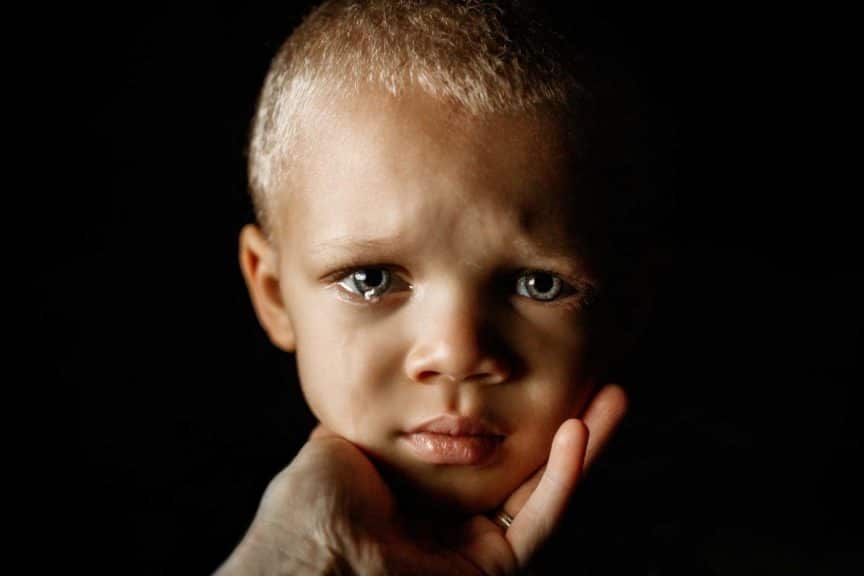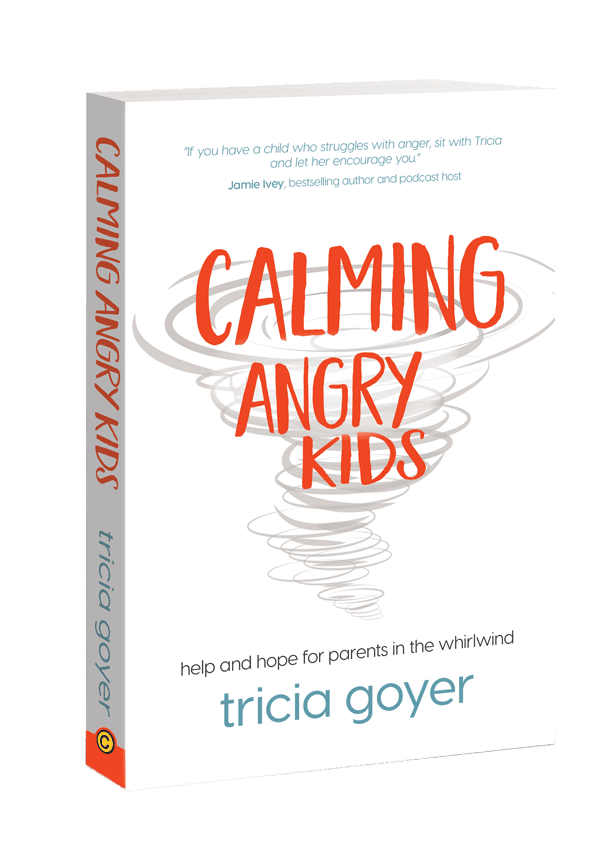I hunkered down, face to face with the five-year-old girl. Her red bow was crooked, and brown hair hung in her face.
Even then, I noted the angry glare behind her bangs. “I don’t want to sit down. I want Mommy!” She balled her fists, stomped her foot, and then let out a scream.
As a young Sunday School teacher, I wasn’t sure how to respond. I told her how much fun we were going to have. I urged her to give the class a chance.
If I would have had candy to offer her to calm down, I would have lowered myself to a bribe.
As her voice rose in volume, I felt I had no choice but to but to ask my helper to page her mom. When the mom arrived, I felt defeated and embarrassed at not being able to calm her.

Yet, that instance was minor compared to other times when a child’s anger was harder to control and even put other kids in harm’s way.
As teachers and leaders, we never know what to expect.
The good news is that we can prepare ourselves and learn important tools to help us calm angry children in our church program—and help ourselves remain calm in the process.
Know Anger Will Happen
As teachers, the best way to prepare is to know anger will happen. Anger happens for many reasons, including anxiety, worry, and overstimulation.
Even when we try to create a fun and loving environment, children can see Sunday School or children’s church as the unknown. It’s yet another place to struggle to fit in and learn a new way of doing things.
The thing is, anger not only happens with kids, it happens with teachers too.
Anger happens when we’re dealing with an angry child. It happens when we can’t get students to listen or obey us. It happens when we’re tired and frustrated and when our volunteers don’t show up to help.
When dealing with anger, it’s easier to deal with our own anger first.
When we stay calm, we are able to help kids to calm down. If we escalate with an angry child, we lose control of ourselves and of the program.
To calm yourself: take a deep breath, unclench your fists, loosen your jaw, and always send up a prayer for strength. Also, keep your voice low. A loud voice escalates an angry child even more.
As we stay calm, we can then offer help in these ways:
1. Understand that anger is a sign that something else is going on.
“Anger is what we call a cover-up emotion, a sign that says something is wrong. But the real problem is always underneath,” said Dr. Lynn Weiss, psychotherapist and author of several books on ADHD. (Lynn Weiss, as quoted by Janis Leibs Deworkis in “Behind the Mask of Teenage Anger.” Scouting, September 2002, 28–30.)
So what are some of the deeper emotions behind these thoughts?

For every reason a child feels angry, there is a deeper, underlying emotion. And the truth is, it’s the same with us.
When I start getting angry and stressed because of loud or uncontrolled children in my Sunday School classroom, it’s because of emotions and fears bubbling under the surface.
When I’m not in control, I worry about what church members or parents will think of me. At that moment the anger isn’t about the children’s actions, it’s about feeling incapable or disrespected.
When children are in the classroom, they often are bringing with them emotions from that morning or even the previous week. Anger is always more than what’s happening in the moment.
These may be a child’s thoughts:
- Things didn’t go as planned. (I feel powerless)
- I messed up. (I feel incapable.)
- I don’t know this teacher or the other kids. (I feel unseen or unheard.)
- It’s not fair! (I feel anxious.)
- Everyone treats me bad. (I feel disconnected.)
- He/she was mad at me first. (I feel unloved.)
- I can’t control myself. (I feel helpless.)
- I can’t explain what I need. (I am hungry, tired, or overstimulated.)
- People don’t act like they should. (I feel threatened.)
- I’m really mad about something else. (I feel confused.)
Instead of jumping to straight to discipline, see anger as a welcome mat telling you that something is going on inside a child’s mind and heart.
2. When you see anger, frustration, or anxiety in one of your students, label it.
Often we try to distract children. We offer them “bribes” by telling them how fun class will be.
We can even issue threats: “You need to calm down, or I’m going to have to get your parent.”
A better way to handle the anger is to name the emotion. “You are angry” or “You are anxious.” By labeling the anger, you are letting the child know that you are paying attention and you care.
A better way to handle the anger is to name the emotion.
After you label the child’s emotion, continue with, “Can you tell me about it?” Even young kids can usually express what is wrong.

For a child to explain what’s wrong, he has to stop acting out in angry ways. As a child talks about his problem, he moves from the emotional part of his brain to the thinking part of his brain, helping him to calm.
3. After we acknowledge a child’s emotion, we must then offer our help.
For example: “You are angry, but I’m here to help you. I care about you. God does too. What do you think will help right now?”
Sometimes a child can tell you what she needs.
Maybe she needs a new coloring sheet. Or to sit in the back of the room. Maybe she needs to walk around in the hall for a few minutes. Or sit next to you during story time. She might prefer watching the other kids instead of participating in the activity.
Often it’s an easier fix than we anticipate. If the child can’t tell you what she needs, you can offer ideas.
Children don’t want to stay angry, and just knowing you’re there to offer a solution is a great step to helping the child to calm.
4. Create a Calm Down Kit—a bin with things that can help a child calm down.
We teach children in our classes how to sit for story time and how to line up for the bathroom. Think of this as just another thing to teach to help the class run smoothly.
At the beginning of class, show the children calm-down items and how to use them if they get angry. Show the children how squeezing play dough or spinning a top gives them something to get their minds off of the anger.
Role play getting mad and then going to the bin and calmly sitting down to blow bubbles. (Kids like to watch us role play!)
Or, for an activity one week, work with the children to create this calm down kit, teaching about one of the Fruits of the Spirit: self-control.
Here’s a list of items you can include:
- Bubbles
- Play Dough
- Stress ball
- A small notebook and colored pens
- A spinning top
- A liquid or sand timer
- Scripture verses to read (for older students)
Let children know they have permission to use the items in the kit when they need to calm down.
5. Focus on building connection with a child who is prone to anger.
Even in the midst of class, find a way to connect with the child and offer praise for even small things done right.
Ask the child to be your helper during story time. Ask the child to help you pass out the snack. Be sure to make eye contact, repeat back what the child says, and point out what you appreciate about the child’s help.
This connection will make the child more willing to stay calm and less likely to act out.
6. Remind the child that God is available to help.
One verse to memorize together is Galatians 5:22-23: “But the fruit of the Spirit is love, joy, peace, forbearance, kindness, goodness, faithfulness, gentleness and self-control. Against such things there is no law.”

We can try to control our actions, but it will only get us so far. It’s far better to ask God to help us. God’s Spirit can and will help us to be loving, kind, gentle, and self-controlled.
While all these things will help in the classroom, it’s also important to prepare yourself for the classroom.
During your quiet time throughout the week, pour out your feelings to God.
Pray for all your students, especially children who are known to get angry. Ask God to show you how He sees those challenging kids through His eyes. Ask Him to help you love your students with His love.
By preparing your heart, preparing to help, and teaching children how to calm themselves, anger will be easier to deal with in your church program.
Scripture Verses to Memorize and Use for the Calm Down Kit.
- “Know this, my beloved brothers: let every person be quick to hear, slow to speak, slow to anger; for the anger of man does not produce the righteousness of God” (James 1:19–20 ESV).
- “A gentle answer deflects anger, but harsh words make tempers flare” (Prov. 15:1 NLT).
- “Don’t sin by letting anger control you. Think about it overnight and remain silent” (Ps. 4:4 NLT).
- “Love is patient, love is kind. It does not envy, it does not boast, it is not proud” (1 Cor. 13:4).
- “Above all, love each other deeply, because love covers over a multitude of sins” (1 Pet. 4:8).

The Truth Behind Anger
Parenting expert and mom-in-the-trenches Tricia Goyer helps us build and restore relationship with angry kids rather than disciplining, ignoring, or resenting them.
Resources:
Cook, Julia, and Carrie Hartman. My Mouth Is a Volcano! Chattanooga, TN: National
Center for Youth Issues, 2006.
Curtis, Jamie Lee, and Laura Cornell. Today I Feel Silly: And Other Moods That Make
My Day. New York: Harper Collins, 2007.
McGuire, Andy. Remy The Rhino Learns Patience. Eugene, OR: Harvest House, 2010.
Eggerichs, Emerson. Love and Respect in the Family: The Respect Parents Desire; The
Love Children Need. Nashville, TN: Thomas Nelson, 2013.
Feldhahn, Shaunti and Lisa A. Rice. For Parents Only: Getting Inside the Head of Your
Kid. Colorado Springs, CO: Multnomah, 2007.
Goyer, Tricia. Calming Angry Kids, Help and Hope for Parents in the Trenches. Colorado
Springs, CO: David C Cook, 2018.







